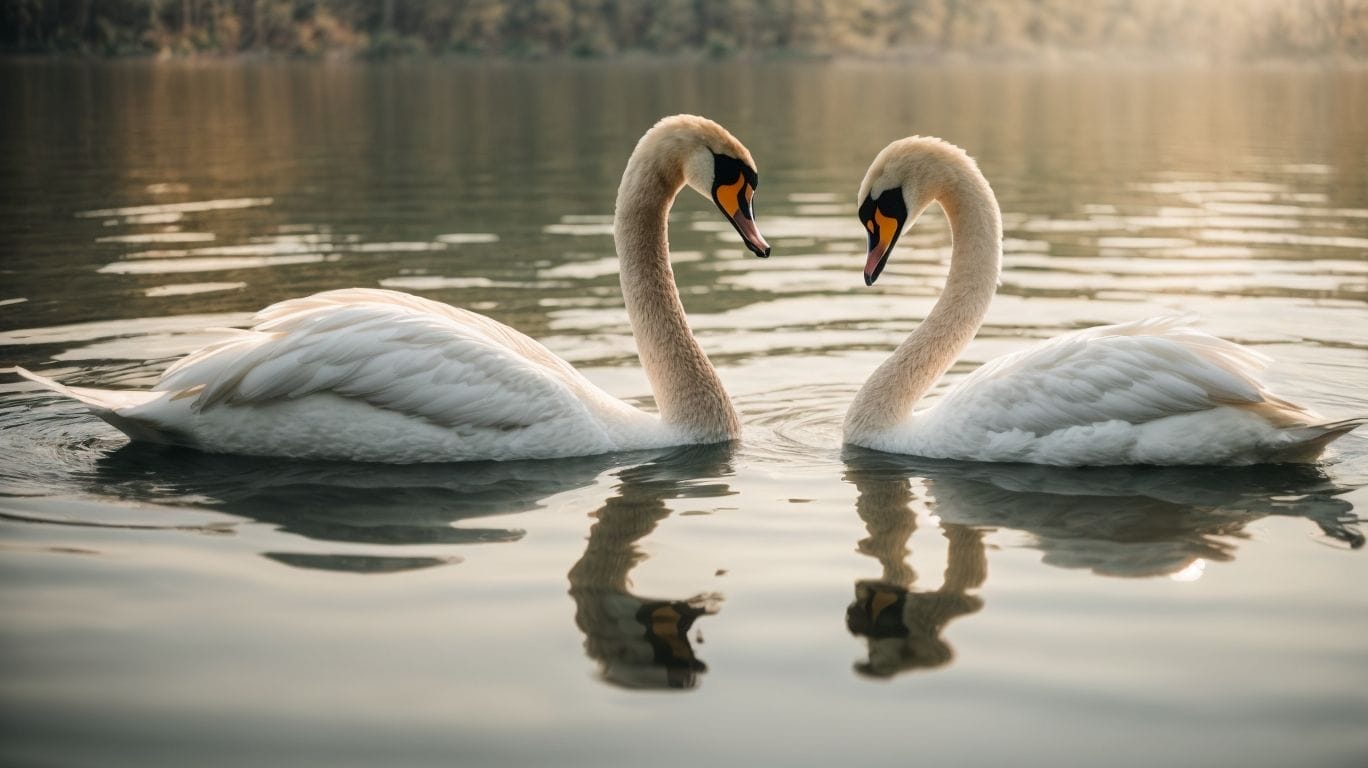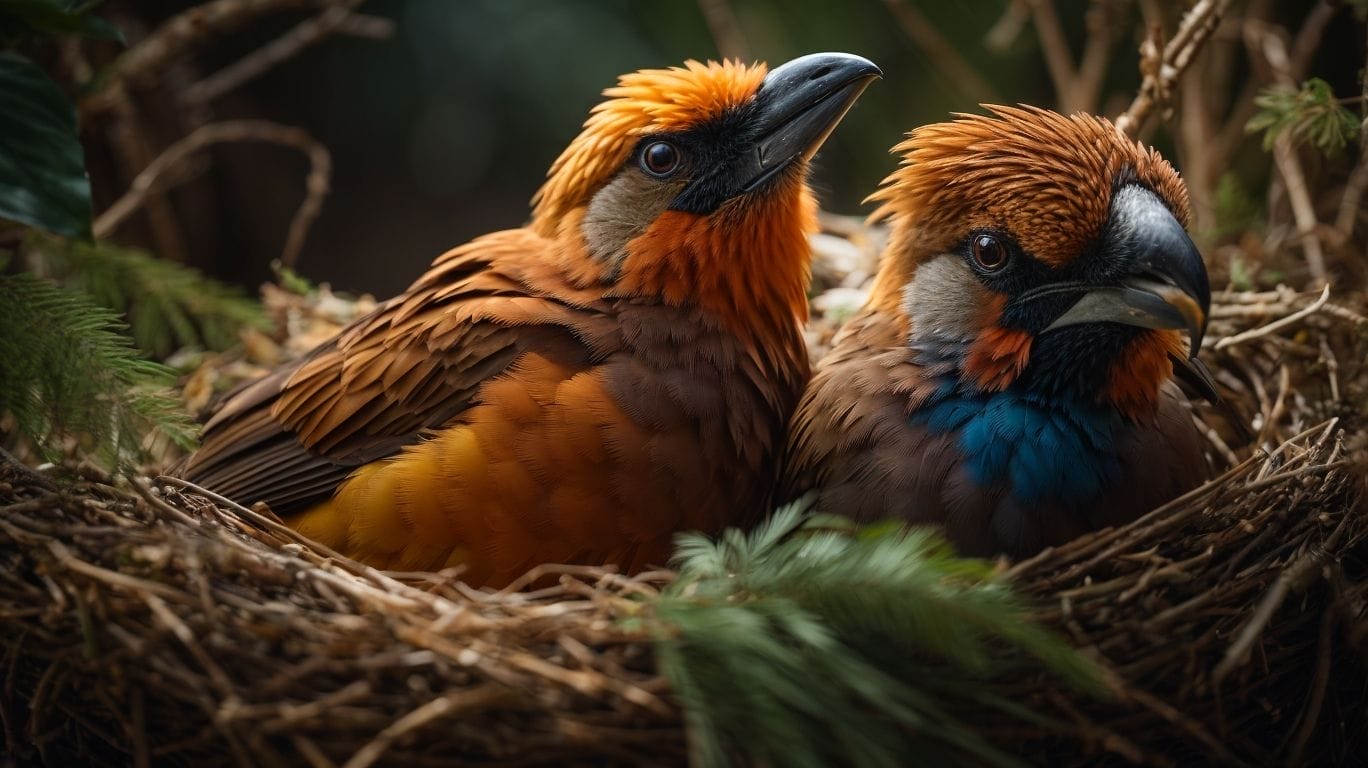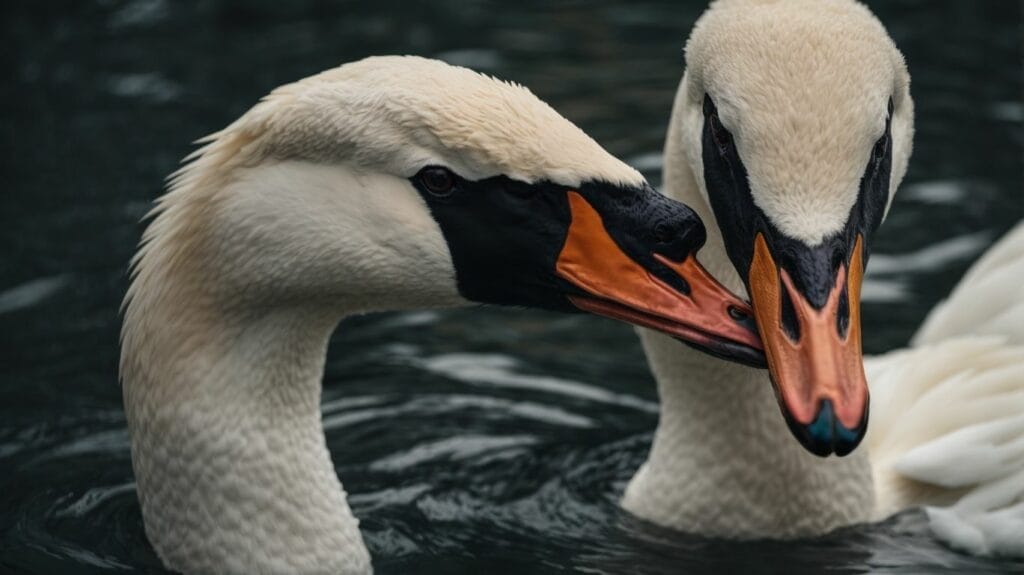Monogamy, the practice of mating with only one partner for a significant period or for life, is a behavior observed in various animal species. While monogamy may not be common among all animals, there are several species that exhibit this unique mating strategy. A closer look at these monogamous animal species reveals fascinating insights into their behavior and social dynamics. Some notable examples include swans, wolves, gibbons, albatrosses, and French angelfish.
There are multiple reasons why monogamy may be advantageous for certain animals. Parental care, where both parents contribute to raising offspring, is a common factor in monogamous species. This shared responsibility helps ensure the survival and success of their young. Monogamy can also be driven by the defense of resources, such as territories or food sources, which are crucial for the survival of the pair and their offspring. Another reason for monogamy is the prevention of infidelity and competition with other mates, reducing the risk of disease transmission and genetic confusion. By staying loyal to one partner, these animals maximize the success of their offspring.
While monogamy is not the norm across the entire animal kingdom, there are some unusual cases that challenge traditional notions. Lovebirds, prairie voles, and even certain parasites like Schistosoma mansoni exhibit monogamous behavior. These unique cases provide further insight into the complexities of mate selection and bonding in different species.
However, it’s important to note that monogamy is not the exclusive mating strategy in the animal kingdom. Serial monogamy, where individuals form pair bonds for a limited period before seeking new partners, is also prevalent. Extra-pair copulations and promiscuous behavior can be observed among various animal species, highlighting the diversity of mating strategies and social structures.
Understanding the various forms of monogamy and exploring the reasons behind this behavior in different animal species can shed light on the fascinating dynamics of mate selection, reproductive success, and social relationships in the animal kingdom.
Key takeaway:
- Monogamy is observed in various animal species: Swans, wolves, gibbons, albatrosses, and French angelfish are some examples of animals that mate for life.
- Monogamy in animals serves different purposes: Parental care, resource defense, prevention of infidelity, and maximizing offspring success are some reasons for monogamy in the animal kingdom.
- Not all animals practice monogamy: Serial monogamy, extra-pair copulations, and promiscuity are alternative mating strategies observed in some animal species.
Monogamous Animal Species: A Closer Look

Photo Credits: Petnarnia.Com by Scott Anderson
Monogamous animal species: Let’s dive into the fascinating world of creatures that mate for life. From elegant swans to majestic wolves, playful gibbons to devoted albatrosses, and even the captivating French angelfish, we’ll explore the unique characteristics of each species. Discover the reasons behind their monogamous behavior, intriguing mating rituals, and the remarkable bond that holds them together. Get ready to be amazed by the intricate dynamics of loyalty and love found within the animal kingdom.Swans
Swans are known for their monogamous mating behavior, forming strong pair bonds that can last for many years. Here is some information about swans:
| Species | Common Swan |
| Habitat | Swans can be found in lakes, rivers, and wetlands across the globe. |
| Mating Behavior | Swans mate for life, with both partners participating in nest building, incubation, and caring for the cygnets. |
| Pair Bond | The pair bonds formed by swans are strong and typically last for the lifetimes of both partners. |
| Family Structure | Swans typically raise their offspring together, with both parents actively involved in their care. |
In a true story of swan monogamy, a pair of swans in a park were observed to have been together for over 20 years. Every year, they would return to the same location to build their nest, lay eggs, and raise their cygnets. Their devotion and commitment to each other and their family serve as a beautiful example of the strong bond that swans form.
Wolves
| Species | Mating Behavior | Mating for Life |
| Wolves | Monogamous | Yes |
Wolves are monogamous animals, meaning they form long-term partnerships with a single mate. These pairs are often referred to as alpha male and female. Once they find a mate, wolves typically stay together for life, engaging in exclusive sexual relationships. They cooperate in raising their offspring, sharing the responsibilities of hunting, defending territory, and caring for the pack. This monogamy provides stability and promotes the survival of their young, contributing to the success of the wolf pack.
Gibbons
Gibbons, also known as “smaller apes,” are highly monogamous primates found in Southeast Asia. They form strong bonds with their mates and typically remain together for life. Here is a table highlighting some key characteristics of gibbons:
| Species Name | Habitat | Diet | Behavior |
|---|---|---|---|
| Gibbons | Rainforests | Fruits, leaves, insects | Highly territorial, singing duets |
Gibbons are known for their incredible agility and acrobatic skills. They swing through the trees using their long arms and can cover great distances without touching the ground. These graceful primates engage in territorial singing, where the male and female perform elaborate duets to establish and defend their territory.
Gibbons play a crucial role in maintaining the balance of their forest habitats by dispersing seeds as they consume various fruits. Sadly, these incredible creatures are facing threats such as habitat loss and illegal pet trade, putting their survival at risk. Conservation efforts are vital to ensure the continued existence of gibbons for future generations.
Albatrosses
are monogamous birds that mate for life. They form strong pair bonds and share the responsibilities of raising their young. Here is a table summarizing some key information about albatrosses:
| Albatrosses | ||||||||
|---|---|---|---|---|---|---|---|---|
|
When choosing a partner, albatrosses are selective, and both males and females participate in elaborate courtship rituals. Their monogamous nature ensures long-term bonding and shared effort in raising offspring. It is fascinating to see such long-lasting commitment and cooperation in the animal kingdom.
If you find this topic interesting, you may also want to explore other monogamous animal species such as swans, wolves, and gibbons. Understanding different mating behaviors can provide valuable insights into the diversity of relationships in the animal world.
French Angelfish
, French Angelfish, scientifically known as Pomacanthus paru, are vibrant and striking inhabitants of coral reefs in the western Atlantic Ocean. With a body covered in bright yellow and blue scales, they are a sight to behold. These fish form monogamous pairs and are known to stay together for life. They defend their territory as a couple, making it easier to protect their young from predators. French Angelfish lay their eggs on rocky surfaces and guard them until they hatch. This dedicated parental care is essential for the survival of their offspring. Such fascinating examples of monogamy in the animal kingdom remind us of the extraordinary bonds that can be formed in nature.
Reasons for Monogamy in Animals

Photo Credits: Petnarnia.Com by Andrew Walker
Why do some animals choose to be monogamous? In this section, we’ll explore the reasons behind monogamy in the animal kingdom. From the benefits of parental care to the importance of resource defense, we’ll uncover the fascinating factors that contribute to monogamous relationships in the animal world. Prepare to be amazed as we delve into the intricate strategies that animals employ to prevent infidelity and maximize the success of their offspring. Get ready for a wild journey into the world of monogamy in animals!Parental Care
Parental care is a critical aspect in facilitating monogamy in animals. It entails the joint involvement of both parents in nurturing and raising their young. This conduct is widely observed among species like swans, wolves, and gibbons. By offering care and safeguarding, parents enhance the survival prospects and overall reproductive success of their offspring. Additionally, parental care enables the allocation of resources and serves as a protective measure against potential threats. This investment in their progeny proves advantageous for monogamous animals as it ensures the well-being and proper development of their young.
Resource Defense
Resource defense is a crucial factor behind the practice of monogamy in certain animal species. By establishing a monogamous bond, animals are able to safeguard and shield their valuable resources, including territory, food, and nesting sites. This approach guarantees exclusive access to these resources, subsequently enhancing the likelihood of survival for both partners and their offspring. Take, for instance, wolves who diligently defend their territory in unison, thus ensuring a stable food supply for their pack. Similarly, French angelfish opt for monogamous pairs to safeguard their preferred coral habitat. Through collaborative resource defense, these animals significantly elevate their reproductive success and overall fitness.Prevention of Infidelity
Prevention of infidelity in monogamous animal species is crucial to ensure the survival and success of offspring. This is achieved through a variety of strategies:
1. Strong pair bonding: Monogamous animals often develop strong emotional bonds with their partners, which effectively deters them from seeking other mates.
2. Mutual mate guarding: Both male and female partners actively defend their territory and prevent other individuals from intruding, significantly reducing the chances of infidelity.
3. Enhanced parental care: Monogamous species typically exhibit elevated levels of parental care, with both parents actively contributing to the upbringing of their offspring. This minimizes the need to seek additional mates.
4. Vocal or visual signals: Monogamous animals may employ vocalizations or visual displays to communicate ownership and discourage potential rivals from approaching their partner.
One remarkable example of preventing infidelity can be observed in the behavior of the African wild dog. These social animals engage in cooperative breeding, where only the dominant male and female within a pack mate and reproduce. Other members of the pack assist in raising the pups of the alpha pair, ensuring their survival and greatly reducing the risk of infidelity.
Maximizing Offspring Success
Maximizing Offspring Success is a crucial factor in the monogamous behavior of animals. Here are some steps that animals take to ensure the success of their offspring:
- Providing parental care: Monogamous species often exhibit higher levels of parental care, which greatly contributes to Maximizing Offspring Success by increasing the survival rate and overall success of their offspring.
- Cooperation in raising offspring: Both parents work together to provide food, protection, and guidance to their young, greatly enhancing their chances of survival and Maximizing Offspring Success in the long run.
- Sharing the workload: Monogamous animals share the responsibilities of finding food, building nests, and defending their territory, ensuring a more efficient allocation of resources and ultimately leading to Maximizing Offspring Success.
- Defending territories: Monogamous animals defend their territories together, minimizing the risk of predation and ensuring a safe environment for their offspring to thrive, thus Maximizing Offspring Success.
Fact: The French angelfish is a remarkable example of monogamous behavior, where the male and female work together to guard their eggs until they hatch, effectively ensuring the survival and Maximizing Offspring Success of their offspring.
Unusual Cases of Monogamy in the Animal Kingdom

Photo Credits: Petnarnia.Com by Jacob Walker
In the fascinating realm of the animal kingdom, we uncover some remarkable instances of monogamy that defy conventional norms. Journey with us as we explore unusual cases of monogamy in a variety of species. From the affectionate lovebirds to the devoted prairie voles, and even the captivating Schistosoma mansoni, we’ll unravel the intriguing dynamics of these partnerships. Get ready to be amazed by the diverse ways in which animals choose to mate for life.Lovebirds
Lovebirds are small, colorful parrots known for their strong bond and devotion to their mate. Here are some key facts about lovebirds:
- Species: Lovebirds belong to the genus Agapornis, which includes several species such as the Fischer’s lovebird, the peach-faced lovebird, and the masked lovebird.
- Mating for Life: Lovebirds are known for forming strong pair bonds and often mate for life. Once they find their partner, they engage in mutual grooming, vocalizations, and even feeding each other.
- Communication: Lovebirds have a complex vocal repertoire and use various calls and chirps to communicate with their mate.
- Behavior: Lovebirds are highly social birds and thrive in pairs or small flocks. They enjoy playing, climbing, and chewing on toys or branches.
- Personality: Each lovebird has its unique personality. While some are more outgoing and interactive, others may be shy or reserved.
There is a poignant story about a pair of lovebirds named Romeo and Juliet. They were inseparable and had been together for over 20 years. Unfortunately, their owner passed away, leaving the lovebirds without a home. The local bird sanctuary recognized their bond and made sure they were adopted together. Now, Romeo and Juliet continue to live happily, reminding us of the enduring love that can be found in these beautiful birds.
Prairie Voles
Prairie Voles are a remarkable species of rodents known for their distinctive monogamous mating behavior. These fascinating creatures form enduring pair bonds with a single partner, engaging in various activities such as huddling, grooming, and nest building. The phenomenon of monogamy in Prairie Voles primarily arises from their strong social attachments between mates, as well as the presence of oxytocin and vasopressin receptors in their brains. One unique aspect of their behavior is their cooperative parenting, where both parents actively participate in the care of their young. Through extensive research, scientists have studied Prairie Voles extensively to gain insights into the underlying neural mechanisms responsible for monogamy in animals. Consequently, these incredible creatures offer valuable insights into the intricate evolution and biology of monogamous behavior.
Schistosoma mansoni
Schistosoma mansoni is a parasitic worm that causes schistosomiasis, a disease affecting millions worldwide. It is an interesting case of monogamy in the animal kingdom. This parasite mates for life, with each male worm pairing with a single female worm inside the host’s blood vessels. This monogamous behavior ensures the successful reproduction of the parasites and the continuation of the life cycle. Studying the mating habits of Schistosoma mansoni is crucial for understanding the transmission and control of schistosomiasis. By uncovering the factors that drive monogamy in this species, scientists hope to develop effective strategies to combat the disease and protect human health.
| Parasite | Mating Behavior |
| Schistosoma mansoni | Mates for life |
Understanding the unique monogamous behavior of Schistosoma mansoni opens up possibilities for targeted interventions and control strategies. By disrupting the mating habits of the parasite, it may be possible to reduce the spread of schistosomiasis and improve global health. Research into the reproductive biology of Schistosoma mansoni is ongoing, aiming to shed light on the mechanisms underlying monogamy and identifying potential vulnerabilities that can be targeted for intervention. Further studies on this monogamous parasite may provide valuable insights into the evolution of mating strategies and the factors influencing the behavior of other parasites and organisms in the animal kingdom.
Is Monogamy the Norm in the Animal Kingdom?

Photo Credits: Petnarnia.Com by Stephen Hall
Is monogamy the norm in the animal kingdom? Let’s dive into the fascinating world of animal mating habits and explore if there’s a universal inclination towards monogamy. We’ll take a closer look at serial monogamy, extra-pair copulations, and promiscuity, unraveling the complexities and surprises that lie within the realm of animal relationships. From unexpected partnerships to varied mating strategies, get ready to uncover the secrets of the animal kingdom’s love lives.Serial Monogamy
Serial monogamy is a widely observed mating strategy among various animal species. Within this particular type of monogamy, individuals establish pair bonds that last for a specific breeding season or period before seeking new partners in subsequent seasons. Many songbirds, certain primates, dolphins, and some insects are examples of species that engage in serial monogamy. This mating strategy offers numerous advantages, including enhanced offspring survival, shared parental care, and increased genetic diversity. It also allows individuals to experience different genetic partners and adapt to changing environmental conditions. Consequently, serial monogamy plays a pivotal role in maintaining a balance between reproductive success and genetic variation within the animal kingdom. To delve further into this topic, consider reading “The Evolution of Monogamy” by David P. Barash and “Monogamy: Mating Strategies and Partnerships in Birds, Humans, and Other Mammals” by Ulrich H. Reichard.
Extra-Pair Copulations
Extra-pair copulations (EPCs) are instances where animals form temporary mating partnerships, outside of their monogamous relationship. EPCs, also known as Extra-Pair Copulations, are observed in various species, including birds and mammals. In birds, Extra-Pair Copulations can occur when a male mates with females other than his long-term partner. This behavior is seen in species like the blue tit and the pied flycatcher. Extra-Pair Copulations can result in increased genetic diversity and can be influenced by factors such as resource availability and mate quality. Understanding Extra-Pair Copulations helps researchers gain insights into the complexities of mating systems in the animal kingdom.
Promiscuity
Promiscuity refers to the practice of having multiple sexual partners without forming a long-term bond. In the animal kingdom, promiscuity is observed in various species for different reasons. Here are some examples of animals known for their promiscuous behavior:
- Bonobos: These primates engage in frequent sexual activity as a form of social bonding and conflict resolution.
- Bed bugs: These insects reproduce through traumatic insemination, where males pierce the female’s body to transfer sperm.
- Anglerfish: The males of some anglerfish species fuse with the females, becoming parasitic mates, solely existing to provide sperm.
- Yellow dung flies: These flies engage in promiscuous behavior to maximize genetic diversity and increase reproductive success.
It’s important to note that promiscuity is not the norm in all animal species. Many animals, such as swans, wolves, and gibbons, mate for life and exhibit monogamous behavior.
Historically, promiscuity has always been a part of human culture. Ancient civilizations, such as the Greeks and Romans, had a more open attitude towards sexual relationships, with multiple partners being accepted and even celebrated. This acceptance of promiscuity has continued through various periods and cultures, shaping the diverse and complex history of human sexuality.
Some Facts About What Animals Mate for Life:
- ✅ Lifelong monogamous relationships are more common among birds than mammals. (Source: World Wildlife Foundation)
- ✅ Beavers are one of the animals that mate for life. (Source: Britannica)
- ✅ Wolves form lifelong partnerships, with only the alpha male and female allowed to breed. (Source: Britannica)
- ✅ Gibbons sometimes cheat on their mates but often reunite and show affection through mutual grooming and co-parenting. (Source: Britannica)
- ✅ Bald eagles solidify their bond by building nests together and are incredibly faithful to their partners. (Source: Best Life Online)


